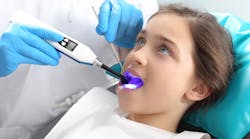There are several important considerations when you’re deciding whether to place sealants. A thorough risk assessment must include several factors, such as a history of carious lesions or the presence of deep fissures and grooves in the topography of the tooth; lack of access to both fluoridated drinking water and regular dental care; and white spot lesions indicating areas of enamel demineralization. A thorough caries risk assessment is not complete without taking xerostomia into account. A multifactorial approach is best when you’re tailoring treatment to a patient’s individual needs.
Contraindications to consider are allergic reactions to any of the materials in the sealant, carious lesions extending into the dentin, insufficient eruption, and proximal caries. Well coalesced surfaces, fused fissures, and the absence of deep pits will not benefit from sealant placement.1
Today we have a large variety of sealant products at our fingertips. The first generation of sealants was developed using ultraviolet light to cure. The second generation was autopolymerized, while the third generation cured using visible light. The most exciting addition to the fourth generation was a fluoride-releasing agent (figure 1).2
Materials used in the composition of sealants vary between products. Other than polymerization methods, they can be either filled or unfilled, tinted or clear, or resin-based. Dental composite resins have been used as popular materials to restore teeth since their introduction about 50 years ago.3
There has been some concern about the bisphenol A-glycidyl methacrylate (BISGMA) components and estrogenic response in humans. Due to the small dosage and route of administration, there has been negligible evidence of eliciting untoward reactions.4 Resin-based sealants are harder and therefore more resistant to occlusal wear, making them ideal for bruxers.
Recommended sealant products and techniques
The success of sealants is technique sensitive. Most products require maintaining a dry field, which can be difficult in squirmy children. Embrace by Pulpdent has demonstrated reliability over time after being wet bonded.5 In a study published in the International Journal of Clinical Pediatric Dentistry, the general consensus comparing several glass ionomer products to resin-based sealants showed little to no statistical difference in retention at three months, while at six, nine, and 12 months the resin-based materials were significantly better.6 Occlusal forces over time will wear at the sealant material, showing that the harder resin-based materials last longer and are more resistant to daily chewing and bruxing habits.
Grandio Seal by VOCO is a highly filled nanohybrid material. Using the latest technology of resin to increase the hardness of the sealant, Grandio Seal resists the wear of occlusal forces to increase retention. A comparison of VOCO’s product to other popular sealant materials demonstrates that the 70% fillers used in Grandio Seal make it harder and more resistant to wear. Three of the products used in this study—Helioseal, Embrace, and Clinpro—were more easily abraded.7
Typically, acid etching precedes sealant placement. The adhesion to the enamel is not determined by the properties of a bonding agent, but by the properties of the fissure sealant. The better the flow of the sealant, the less likely bubbles will form, and air bubbles negatively affect the integrity of the sealant, leading to lack of retention and sealant failure. The better the material can infiltrate the small recesses in the enamel produced by etching, the higher the micro-retention and increased adhesion to the enamel. For example, Grandio Seal has very good flow behavior, therefore it flows into the smallest enamel recesses and leads to high enamel adhesion.
Application is another aspect to consider when comparing sealants. Advancements such as Grandio Seal’s patented nondripping technology ultra-fine intraoral tip allows operators to have complete control when dispensing it into the pits and fissures without the use of a brush to agitate the material. The unique thixotropic properties of the material decrease the viscosity, encouraging complete entry to the base of the fissure. Grandio Seal provides better material penetration into deep fissures without the introduction of bubbles. Thanks to these properties, Grandio Seal is highly effective for long-lasting and marginally tight fissure sealing.8
References
- Perno Goldie M.. Dental Hygiene: Applications to Cinical Practice. 2016. FA Davis. p.366
- Dental sealant. Wikipedia en.wikipedia.org/wiki/Dental_sealant. Accessed October 2020.
- Chen K, Qingsong Y, Wang Y, Li H. BISGMA/TEGDMA dental composite containing high aspect-ratio hydroxyapatite nanofibers. Dent Mater. 2011;27(11):1187-1195
- Soderholm KJ, Mariotti A. BISGMA-based resins in dentistry: are they safe? J Am Dent Assoc. Accessed November 2020. 1999;130(2):201-209.
- Embrace WetBond pit & fissure sealant. Pulpdent. Accessed November 2020. https://www.pulpdent.com/embrace-wetbond-pit-fissure-sealant
- Hassan AM, Mohammed SG. Effectiveness of seven types of sealants: retention after one year. Accessed November 2020. Int J Clin Pediatr Dent. 2019;12(2):96-100. doi:10.5005/jp-journals-10005-1600
- Mürnseer M, Rosentritt M, Behr G. Handel G. Three-body wear of fissure sealants. Abstract Archives. March 22, 2000. Accessed November 2020. https://iadr.abstractarchives.com/abstract/2007Orleans-88913/three-body-wear-of-fissure-sealants
- Highly filled nano-hybrid pit and fissure sealant. VOCO. Accessed November 2020. https://www.voco.dental/us/products/preventive-care/fissure-sealing/grandio-seal.aspx
Editor's note: This article appeared in the March 2022 print edition of RDH magazine. Dental hygienists in North America are eligible for a complimentary print subscription. Sign up here.








